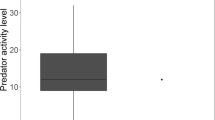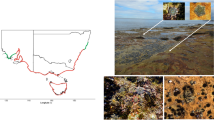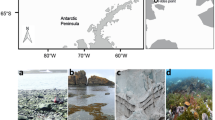Abstract
Many marine gastropods show species-specific behavioral responses to different predators, but less is known about the mechanisms influencing differences or similarities in specific responses. Herein, we examined whether two limpet species, Scurria viridula (Lamarck, 1819) and Fissurella latimarginata (Sowerby, 1835), show species- and size-specific similarities or differences in their reaction to predatory seastars and crabs. Both S. viridula and F. latimarginata reacted to their main seastar predators with escape responses. In contrast, both limpets did not flee from common crab predators, but, instead, fastened to the rock. All tested size classes of both limpet species reacted in a similar way, escaping from seastars, but clamping onto the rock in response to crabs. Limpets could reach velocities sufficient to outrun their specific seastar predators, but they were not fast enough to escape crabs. Experiments with limpets of different shell conditions (with and without shell damage) indicated that F. latimarginata with a damaged shell showed “accommodation movements” (slow movements away from stimulus) in response to predatory crabs. In contrast, intact F. latimarginata and all S. viridula (intact and damaged) clamped the shell down to the substratum. The response details suggest that the keyhole limpet F. latimarginata is more sensitive to predators (faster reaction time, longer escape distances, and higher proportion of reacting individuals) than S. viridula, possibly because the morphology of F. latimarginata (the relationship of its shell size and structure to its total body size) makes this species more vulnerable to predation. Our study suggests that chemically mediated effects of seastar and crab predators result in contrasting behavioral responses of both limpet species, independent of their habitat and morphology. Despite the different characteristics of the limpet species and the identity of predators, the limpets react in comparable ways to similar predator types.


Similar content being viewed by others
References
Aguilera MA, Valdivia N, Broitman B (2013) Spatial niche differentiation and coexistence at the edge: co-occurrence distribution patterms in Scurria limpets. Mar Ecol Prog Ser 483:185–198
Ansell AD (1969) Escape responses of three Indian molluscs. Veliger 12:157–159
Bancala F (2009) Function of mucus secretion by lamellose ormer, Haliotis tuberculata lamellosa, in response to starfish predation. Anim Behav 78:1189–1194
Barahona M, Navarrete S (2010) Movement patterns of the seastar Heliaster helianthus in central Chile: relationship with environmental conditions and prey availability. Mar Biol 157:647–661
Bertness MD, Cunningham C (1981) Crab shell-crushing predation and gastropods architectural defense. J Exp Mar Biol Ecol 50:213–230
Branch GM (1985) The impact of predation by kelp gulls Larus dominicanus on the sub-antarctic limpet Nacella delesserti. Polar Biol 4:171–177
Brock KM, Bednekoff PA, Pafilis P, Foufopoulos P (2015) Evolution of antipredator behavior in an island lizard species, Podarcis erhardii (Reptilia: Lacertidae): the sum of all fears? Evolution 69:216–231
Cedeño J, Voltzow J, Fetcher N (1996) Morphological differences between the pedal musculature of patellogastropod and fissurellid limpets. Veliger 39:164–172
Cohen J (1988) Statistical power analysis for the behavioral sciences, Second edn. Lawrence Erlbaum Associated Publishers, Mahwah, New Jersey, USA, p 551
Coleman RA, Browne M, Theobald T (2004) Aggregation as defense: limpet tenacity changes in response to simulated predator attack. Ecology 85:1153–1159
Dalby JE, Elliot JK, Ross DM (1987) The swim response of the actinian Stomphia didemon to certain asteroids: distributional and phylogenetic implications. Can J Zool 66:2484–2491
Dalesman S, Rundle SD, Cotton PA (2009) Crawl-out behaviour in response to predation cues in an aquatic gastropods: insights from artificial selection. Evol Ecol 23:907–918
Dayton PK, Rosenthal RJ, Mahen LC, Antezana T (1977) Population structure and foraging biology of the predaceous Chilean asteroid Meyenaster gelatinosus and the escape biology of its prey. Mar Biol 39:361–370
Dee LE, Witman JD, Brandt M (2012) Refugia and top-down control of the pencil urchin Eucidaris galapaguensis in the Galápagos marine reserve. J Exp Mar Biol Ecol 416–417:135–143
Donovan D, Baldwin J, Carefoot T (1999) The contribution of anaerobic energy to gastropod crawling and a re-estimation of minimum cost of transport in the abalone, Haliotis kamtschatkana (Jonas). J Exp Mar Biol Ecol 235:273–284
Escobar JB, Navarrete SA (2011) Risk recognition and variability in escape responses among intertidal molluskan grazers to the sun star Heliaster helianthus. Mar Ecol Prog Ser 421:151–161
Espoz C, Castilla JC (2000) Escape responses of four Chilean intertidal limpets to seastars. Mar Biol 137:887–892
Espoz C, Lindberg DR, Castilla JC, Simison WB (2004) Los patelogastrópodos intermareales de Chile y Perú. Rev Chil Hist Nat 77:257–283
Feder HM (1963) Gastropod defensive responses and their effectiveness in reducing predation by starfishes. Ecology 40:505–512
Feder HM (1972) Escape responses in marine invertebrates. Sci Am 227:93–100
Fernández M, Blanco M, Ruano-Chamorro C, Subida MD (2017) Reproductive output of two benthic resources (Fissurella latimarginata and Loxechinus albus) under different management regimes along the coast of central Chile. Lat Am J Aquat Res 45:391–402
Ferrari MCO, Wisenden BD, Chivers DP (2010) Chemical ecology of predator-prey interactions in aquatic systems: a review and prospectus. Can J Zool 88:698–724
Formanowicz DR, Brodie ED (1988) Predation risk and forager escape tactics. Anim Behav 36:1836–1860
Freeman AS (2007) Specificity of induced defenses in Mytilus edulis and asymmetrical predator deterrence. Mar Ecol Prog Ser 334:145–153
Garrity SD, Levings SC (1983) Homing to scars as a defense against predators in the pulmonate limpet Siphonaria gigas (Gastropoda). Mar Biol 72:319–324
Gaymer CF, Himmelman JH (2008) A keystone predatory sea star in the intertidal zone is controlled by a higher-order predatory sea star in the subtidal zone. Mar Ecol Prog Ser 370:143–153
Geller JB (1982) Chemically mediated avoidance response of a gastropod, Tegula funebralis (A. Adams), to a predatory crab Cancer antennarius (Stimpson). J Exp Mar Biol Ecol 65:19–27
Grosholz ED (2005) Recent biological invasion may hasten invasional meltdown by accelerating historical introductions. Proc Natl Acad Sci USA 102:1088–1091
Guderley HE, Himmelman JH, Nadeau M, Cortes HP, Tremblay I, Janssoone X (2015) Effect of different predators on the escape response of Placopecten magellanicus. Mar Biol 162:1407–1415
Himmelman JH, Guderley HE, Duncan PF (2009) Responses of the saucer scallop Amusium balloti to potential predators. J Exp Mar Biol Ecol 378:58–61
Iwasaki K (1993) Analyses of limpet defense and predator offense in the field. Mar Biol 116:277–289
Kikuchi T, Dol T (1987) Defensive escape response of two trochid sand snail species of the genus Umbonium: the effect of species-specific escape response to asteroid predators. Publ Amakusa Mar Biol Lab 9:47–65
Kirk RE (1996) Practical significance: a concept whose time has come. Educ Psychol Meas 56:746–759
Lam KKY (2002) Escape responses of intertidal gastropods on a subtropical rocky shore in Hong Kong. J Moll Stud 68:297–306
Lima SL (1998) Nonlethal effects in the ecology of predator-prey interactions. Bioscience 48:25–34
Lima SL, Dill LM (1990) Behavioral decisions made under the risk of predation: a review and prospectus. Can J Zool 68:619–640
Lindberg DR (1991) Marine biotic interchange between the northern and southern hemispheres. Paleobiology 17:308–324
Mahon AR, Amsler CD, McClintock JB, Baker BJ (2002) Chemo-tactile predator avoidance responses of the common Antarctic limpet Nacella concinna. Polar Biol 25:469–473
Manzur T, Navarrete SA (2011) Scales of detection and escape of the sea urchin Tetrapygus niger in interactions with the predatory sun star Heliaster helianthus. J Exp Mar Biol Ecol 407:302–308
Manzur T, Vidal F, Pantoja JF, Fernández M, Navarrete SA (2014) Behavioural and physiological responses of limpet prey to a seastar predator and their transmission to basal trophic levels. J Anim Ecol 83:923–933
Markowska M, Kidawa A (2007) Encounters between Antarctic limpets, Nacella concinna, and predatory sea stars, Lysasterias sp., in laboratory and field experiments. Mar Biol 151:1959–1966
McLean JH (1984) Systematics of Fissurella in the Peruvian and Magallanic Faunal Provinces. Natural History Museum of Los Angeles County, Los Angeles. Contrib Sci 354:70
Menge BA (1982) Effects of feeding on the environment: Asteroidea. In: Jangoux M, Lawrence JM (eds) Echinoderm nutrition. Balkema, Rotterdam, pp 521–551
Mercurio KS, Palmer AR, Lowell RB (1985) Predator-mediated microhabitat partitioning by two species of visually cryptic, intertidal limpets. Ecology 66:1417–1425
Miller LP, Harley CDG, Denny MW (2009) The role of temperature and desiccation stress in limiting the local-scale distribution of the owl limpet, Lottia gigantea. Funct Ecol 23:756–767
Navarrete S, Manzur T (2008) Individual- and population-level responses of a keystone predator to geographic variation in prey. Ecology 89:2005–2018
Olejnik S, Algina J (2003) Generalized Eta and Omega squared statistics. Measures of effect size for some common research designs. Psychol Methods 8:434–447
Paine RT (1969) The Pisaster—Tegula interaction: prey patches, predator food preference and intertidal community structure. Ecology 50:950–961
Phillips DW (1978) Chemical mediation of invertebrate defensive behaviors and the ability to distinguish between foraging and inactive predators. Mar Biol 49:237–243
Powers SP, Kittinger JN (2002) Hydrodynamic mediation of predator-prey interactions: differential patterns of prey susceptibility and predator success explained by variation in water flow. J Exp Mar Biol Ecol 273:171–187
Pruitt NJ, Stachowicz JJ, Sih A (2012) Behavioral types of predator and prey jointly determine prey survival: potential implications for the maintenance of within-species behavioral variation. Am Nat 179:217–227
R Development Core Team R (2018) R: a language and environment for statistical computing. R Found Stat Comput. http://dx.doi.org/10.1007/978-3-540-74686-7
Rochette R, Dill LM (2000) Mortality, behavior and the effects of predators on the intertidal distribution of littorinid gastropods. J Exp Mar Biol Ecol 253:165–191
Rochette R, McNeil JN, Himmelman JH (1996) Inter- and intra-population variations in the response of the whelk Buccinum undatum to the predatory astreroid Leptasterias polaris. Mar Ecol Prog Ser 142:193–201
Rochette R, Dill LM, Himmelman JH (1997) A field test of threat sensitivity in a marine gastropod. Anim Behav 54:1053–1062
Rochette R, Arsenault DJ, Justome B, Himmelmann JH (1998) Chemically-mediated predator-recognition learning in a marine gastropod. Ecoscience 5:353–360
Rochette R, Maltais M, Dill LM, Himmelman JH (1999) Interpopulation and context-related differences in responses of a marine gastropod to predation risk. Anim Behav 57:977–987
San-Martin A, Rovirosa J, Gaete K, Olea A, Ampuero J (2009) Mantle defensive response of marine pulmonate Trimusculus peruvianus. J Exp Mar Biol Ecol 376:43–47
Seeley RH (1986) Intense natural selection caused a rapid morphological transition in a living marine snail. Proc Nat Acad Sci USA 83:6897–6901
Sih A, Englund G, Wooster D (1998) Emergent impacts of multiple predators on prey. Trends Ecol Evol 13:350–355
Smee DL, Weissburg MJ (2002) Clamming up: environmental forces diminish the perceptive ability of bivalve prey. Ecology 87:1587–1598
Sokal RR, Rohlf FJ (1981) Biometry. The principles and practice of statistics in biological research. W.H. Freeman, San Francisco, p 859
Stapley J (2004) Do mountain log skinks (Pseudomoia entrecasteauxii) modify their behaviour in the presence of two predators? Behav Ecol Sociobiol 56:185–189
Tokeshi M, Romero L (1995) Quantitative analysis of foraging behaviour in a field population of the South American sun–star Heliaster helianthus. Mar Biol 122:297–303
Trussell GC (1996) Phenotypic plasticity in an intertidal snail: the role of a common crab predator. Evolution 50:448–454
Trussell GC, Ewanchuk PJ, Bertness MD (2003) Trait-mediated effects in rocky intertidal food chains: predator risk cues alter prey feeding rates. Ecology 84:629–640
Turner AM, Turner SE, Lappi HM (2006) Learning, memory and predator avoidance by freshwater snails: effects of experience on predator recognition and defensive strategy. Anim Behav 72:1443–1450
Urriago JD, Himmelman JH, Gaymer CF (2011) Responses of the black sea urchin Tetrapygus niger to its sea-star predators Heliaster helianthus and Meyenaster gelatinosus under field conditions. J Exp Mar Biol Ecol 399:17–24
Urriago JD, Himmelman JH, Gaymer CF (2012) Sea urchin Tetrapygus niger distribution on elevated surfaces represents a strategy for avoiding predatory sea stars. Mar Ecol Prog Ser 444:85–95
Vance SA, Peckarsky BL (1997) The effect of mermithid parasitism on predation of nymphal Baetis bicaudatus (Ephemeroptera) by invertebrates. Oecologia 110:147–152
Vermeij GJ (2016) The limpet form in gastropods: evolution, distribution and implications for the comparative study of history. Biol J Linn Soc 120:22–37
Vermeij GJ, Schindel DE, Zipser E (1981) Predation through geological time: evidence from gastropod shell repair. Science 214:1024–1026
Weissburg M, Smee DL, Ferner MC (2014) The sensory ecology of non-consumptive predator effects. Am Nat 184:141–157
West K, Cohen A, Baron M (1991) Morphology and behavior of crabs and gastropods from Lake Tanganyika, Africa: implications for lacustrine predator-prey coevolution. Evolution 45:589–607
Williams GA, Morritt D (1995) Habitat partitioning and thermal tolerance in a tropical limpet, Cellana grata. Mar Ecol Prog Ser 124:89–103
Wong MC, Barbeau MA (2003) Effects of substrate on interactions between juvenile sea scallops (Placopecten magellanicus Gmelin) and predatory sea stars (Asterias vulgaris Verrill) and rock crabs (Cancer irroratus Say). J Exp Mar Biol Ecol 287:155–178
Zimmer RK, Butman CA (2000) Chemical signaling processes in the marine environment. Biol Bull 198:168–187
Zuur AF, Ieno EN, Walker NJ, Saveliev AA, Smith GM (2009) Mixed effects models and extension in ecology with R, 2nd edn. Springer, New York
Acknowledgements
We are most grateful to S. Boltaña and I. Hinojosa for their help in the field, and to C. Correa who kindly provided the velocity data for M. gelatinosus. Our special thanks go to J. Long, who gave many helpful comments on an early version of the manuscript. This manuscript was substantially improved by numerous constructive comments from four anonymous reviewers and the editors. We greatly appreciate the critical review provided by T. Manzur who commented on the final version of the manuscript, and we thank L. Eastman for editing the English of the final manuscript.
Funding
MAA was financed by FONDECYT #1160223 and PAI-CONICYT #79150002, and MT received support through FONDECYT #1161383 during the writing of the manuscript
Author information
Authors and Affiliations
Contributions
MT and MW conceived the study. MW conducted the field and laboratory experiments. MAA reanalyzed all data and led the writing of the revised manuscript, which had been initially prepared by MT and MW.
Corresponding author
Ethics declarations
Conflict of interest
All authors declare that they have no conflicts of interest.
Ethical approval
All applicable international, national, and/or institutional guidelines for the care and use of animals were followed.
Additional information
Responsible Editor: F. Bulleri.
Reviewed by P. Camus and A. E. Scherer.
Publisher's Note
Springer Nature remains neutral with regard to jurisdictional claims in published maps and institutional affiliations.
Rights and permissions
About this article
Cite this article
Aguilera, M.A., Weiß, M. & Thiel, M. Similarity in predator-specific anti-predator behavior in ecologically distinct limpet species, Scurria viridula (Lottiidae) and Fissurella latimarginata (Fissurellidae). Mar Biol 166, 41 (2019). https://doi.org/10.1007/s00227-019-3485-5
Received:
Accepted:
Published:
DOI: https://doi.org/10.1007/s00227-019-3485-5




